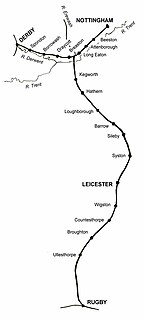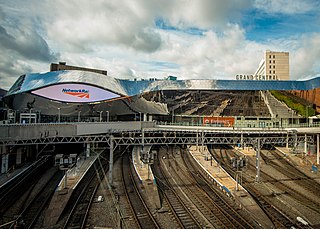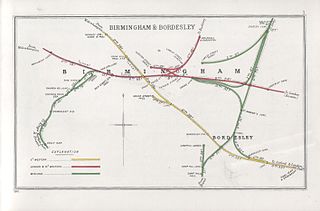
The Grand Junction Railway (GJR) was an early railway company in the United Kingdom, which existed between 1833 and 1846 when it was amalgamated with other railways to form the London and North Western Railway. The line built by the company was the first trunk railway to be completed in England, and arguably the world's first long-distance railway with steam traction.

The Midland Railway (MR) was a railway company in the United Kingdom from 1844. The Midland was one of the largest railway companies in Britain in the early 20th century, and the largest employer in Derby, where it had its headquarters. It amalgamated with several other railways to create the London, Midland and Scottish Railway at grouping in 1922.

The London and Birmingham Railway (L&BR) was an early railway company in the United Kingdom, existing from 1833 to 1846, when it became part of the London and North Western Railway (L&NWR).

The Midland Counties' Railway (MCR) was a railway company in the United Kingdom which existed between 1839 and 1844, connecting Nottingham, Leicester and Derby with Rugby and thence, via the London and Birmingham Railway, to London. The MCR system connected with the North Midland Railway and the Birmingham and Derby Junction Railway in Derby at what become known as the Tri Junct Station. The three later merged to become the Midland Railway.

Birmingham New Street is the largest and busiest of the three main railway stations in Birmingham city centre, England. It is a central hub of the British railway system. It is a major destination for Avanti West Coast services from London Euston, Glasgow Central and Edinburgh Waverley via the West Coast Main Line, the CrossCountry network, and for local and suburban services within the West Midlands, including those on the Cross-City Line between Lichfield Trent Valley, Redditch, and Bromsgrove, and the Chase Line to Walsall and Rugeley Trent Valley. The three-letter station is BHM.

Crewe railway station is a railway station in Crewe, Cheshire, England. It opened in 1837 and is one of the most historically significant railway stations in the world.

Birmingham Curzon Street railway station was a railway station in central Birmingham, England, opening in 1838 and closed to passengers in 1893 but remaining open for goods until 1966. The station was used by scheduled passenger trains between 1838 and 1854 when it was the terminus for both the London and Birmingham Railway and the Grand Junction Railway, with lines to London, Manchester and Liverpool respectively. Excursion trains ran until 1893 after which only goods trains operated until closure in 1966. More recently, the surviving Grade I listed entrance building was used for occasional art events.
The Birmingham and Gloucester Railway (B&GR) was the first name of the railway linking the cities in its name and of the company which pioneered and developed it; the line opened in stages in 1840, using a terminus at Camp Hill in Birmingham. It linked with the Bristol and Gloucester Railway in Gloucester, but at first that company's line was broad gauge, and Gloucester was a point of the necessary but inconvenient transhipment of goods and passengers onto 4 ft 8 1⁄2 in gauge that became the national standard. Nearly all of the original main line remains active as a "trunk" route, also known as an arterial route or line.

The North Midland Railway was a British railway company, which opened its line from Derby to Rotherham (Masbrough) and Leeds in 1840.

The Birmingham and Derby Junction Railway was a British railway company. From Birmingham it connected at Derby with the North Midland Railway and the Midland Counties Railway at what became known as the Tri Junct Station. It now forms part of the main route between the West Country and the North East.
The Stonebridge Railway was a railway line between Whitacre Junction and Hampton-in-Arden in Warwickshire, England, passing through Stonebridge. It had an intermediate station at Coleshill, which was renamed Maxstoke in 1923.

Water Orton railway station serves Water Orton in Warwickshire, near Birmingham, England. It is owned by Network Rail, and managed by West Midlands Trains. However, no West Midlands Trains stop there; it is only served by CrossCountry services.
The Stour Valley Line is the present-day name given to the railway line between Birmingham and Wolverhampton, in England. It was authorised as the Birmingham, Wolverhampton and Stour Valley Railway in 1836; the title was often shortened to the Stour Valley Railway.

Grand Junction is a railway junction in Birmingham, England. It is situated less than one mile east of Birmingham New Street and is thus one of the busiest railway junctions in the UK.

Coleshill Parkway is a railway station at Hams Hall on the Birmingham to Peterborough railway line, serving Coleshill in Warwickshire, England. Sitting on the site of the former Coleshill station which closed in 1968, the current station was opened in 2007, it is owned by Network Rail and managed by West Midlands Trains train operating company (TOC); all rail services are operated by CrossCountry.
The Camp Hill line is a railway line in Birmingham which lies between Kings Norton on the Cross-City Line and Birmingham New Street via Grand Junction on the main lines from Derby and Coventry.

Camp Hill railway station was a railway station in Camp Hill, Birmingham.

Castle Bromwich railway station was a railway station in the Castle Bromwich area of Solihull opened by the Birmingham and Derby Junction Railway in 1842.

Bromford Bridge railway station was a railway station in Birmingham opened by the Midland Railway in 1896.

Whitacre Junction railway station was opened in 1864 by the Midland Railway.

















